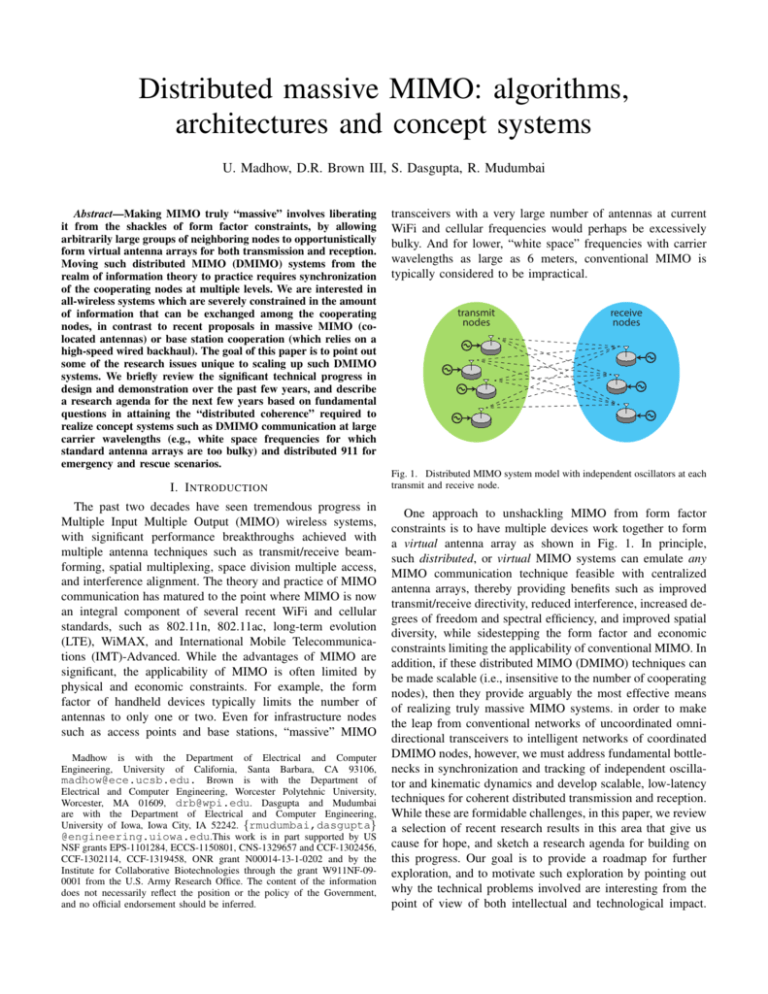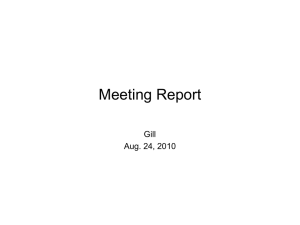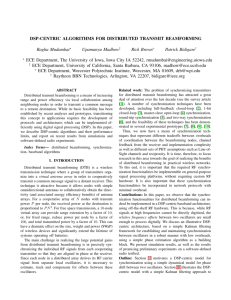Distributed massive MIMO: algorithms, architectures
advertisement

Distributed massive MIMO: algorithms,
architectures and concept systems
U. Madhow, D.R. Brown III, S. Dasgupta, R. Mudumbai
Abstract—Making MIMO truly “massive” involves liberating
it from the shackles of form factor constraints, by allowing
arbitrarily large groups of neighboring nodes to opportunistically
form virtual antenna arrays for both transmission and reception.
Moving such distributed MIMO (DMIMO) systems from the
realm of information theory to practice requires synchronization
of the cooperating nodes at multiple levels. We are interested in
all-wireless systems which are severely constrained in the amount
of information that can be exchanged among the cooperating
nodes, in contrast to recent proposals in massive MIMO (colocated antennas) or base station cooperation (which relies on a
high-speed wired backhaul). The goal of this paper is to point out
some of the research issues unique to scaling up such DMIMO
systems. We briefly review the significant technical progress in
design and demonstration over the past few years, and describe
a research agenda for the next few years based on fundamental
questions in attaining the “distributed coherence” required to
realize concept systems such as DMIMO communication at large
carrier wavelengths (e.g., white space frequencies for which
standard antenna arrays are too bulky) and distributed 911 for
emergency and rescue scenarios.
I. I NTRODUCTION
The past two decades have seen tremendous progress in
Multiple Input Multiple Output (MIMO) wireless systems,
with significant performance breakthroughs achieved with
multiple antenna techniques such as transmit/receive beamforming, spatial multiplexing, space division multiple access,
and interference alignment. The theory and practice of MIMO
communication has matured to the point where MIMO is now
an integral component of several recent WiFi and cellular
standards, such as 802.11n, 802.11ac, long-term evolution
(LTE), WiMAX, and International Mobile Telecommunications (IMT)-Advanced. While the advantages of MIMO are
significant, the applicability of MIMO is often limited by
physical and economic constraints. For example, the form
factor of handheld devices typically limits the number of
antennas to only one or two. Even for infrastructure nodes
such as access points and base stations, “massive” MIMO
Madhow is with the Department of Electrical and Computer
Engineering, University of California, Santa Barbara, CA 93106,
madhow@ece.ucsb.edu. Brown is with the Department of
Electrical and Computer Engineering, Worcester Polytehnic University,
Worcester, MA 01609, drb@wpi.edu. Dasgupta and Mudumbai
are with the Department of Electrical and Computer Engineering,
University of Iowa, Iowa City, IA 52242. {rmudumbai,dasgupta}
@engineering.uiowa.edu.This work is in part supported by US
NSF grants EPS-1101284, ECCS-1150801, CNS-1329657 and CCF-1302456,
CCF-1302114, CCF-1319458, ONR grant N00014-13-1-0202 and by the
Institute for Collaborative Biotechnologies through the grant W911NF-090001 from the U.S. Army Research Office. The content of the information
does not necessarily reflect the position or the policy of the Government,
and no official endorsement should be inferred.
transceivers with a very large number of antennas at current
WiFi and cellular frequencies would perhaps be excessively
bulky. And for lower, “white space” frequencies with carrier
wavelengths as large as 6 meters, conventional MIMO is
typically considered to be impractical.
transmit
nodes
receive
nodes
Fig. 1. Distributed MIMO system model with independent oscillators at each
transmit and receive node.
One approach to unshackling MIMO from form factor
constraints is to have multiple devices work together to form
a virtual antenna array as shown in Fig. 1. In principle,
such distributed, or virtual MIMO systems can emulate any
MIMO communication technique feasible with centralized
antenna arrays, thereby providing benefits such as improved
transmit/receive directivity, reduced interference, increased degrees of freedom and spectral efficiency, and improved spatial
diversity, while sidestepping the form factor and economic
constraints limiting the applicability of conventional MIMO. In
addition, if these distributed MIMO (DMIMO) techniques can
be made scalable (i.e., insensitive to the number of cooperating
nodes), then they provide arguably the most effective means
of realizing truly massive MIMO systems. in order to make
the leap from conventional networks of uncoordinated omnidirectional transceivers to intelligent networks of coordinated
DMIMO nodes, however, we must address fundamental bottlenecks in synchronization and tracking of independent oscillator and kinematic dynamics and develop scalable, low-latency
techniques for coherent distributed transmission and reception.
While these are formidable challenges, in this paper, we review
a selection of recent research results in this area that give us
cause for hope, and sketch a research agenda for building on
this progress. Our goal is to provide a roadmap for further
exploration, and to motivate such exploration by pointing out
why the technical problems involved are interesting from the
point of view of both intellectual and technological impact.
For concreteness, we focus on two canonical MIMO functions,
beamforming and nullforming, and discuss what is entailed in
achieving these in scalable fashion.
We are interested in DMIMO systems that do not rely on
a high-speed backhaul connecting the cooperating nodes, and
we are particularly interested in techniques that scale to a large
number of nodes. Thus, our emphasis is quite different from
DMIMO techniques proposed for base station cooperation,
or “coordinated multipoint” (CoMP) [1], in cellular systems,
which rely on a high-speed wired backhaul, and on explicit
feedback from mobile nodes. A similar comment also applies
to recent work on synthesizing virtual arrays using access
points connected by a wired backhaul in a WiFi network [2],
[3].
We organize the paper as follows. In Section II, we discuss the fundamental problem of synchronizing independently
running oscillators, which is a building block for any coherent DMIMO technique. In Section III, we discuss the
role of aggregate explicit feedback for scalable approaches to
beamforming and nullforming. In Section IV, we discuss the
alternative approach of implicit feedback via reciprocity, and
the challenges in implementing it. Finally, while it is attractive
to view DMIMO techniques as a direct generalization of
centralized MIMO in any context, in practice, it must go hand
in hand with synchronization-enabling protocols that support
it. In Section VII, we discuss such protocol implications
in the context of two concept systems in which DMIMO
plays an essential role (i.e., centralized MIMO is simply not
feasible): synthesizing a distributed base station for white
space communication, and synthesizing a virtual array for
reachback in emergency or disaster relief.
II. H OW TO SYNCHRONIZE OSCILLATORS
The first step to enabling a cluster of cooperating nodes
cohere at radio frequency (RF) is to synchronize their oscillators in frequency and phase. A fairly generic model for
achieving this (which lends itself to many different protocol
implementations) is for the nodes in the cluster to synchronize
to a common beacon. Such a beacon could be broadcast
(typically intermittently) by a “master” node in the cluster,
or by a distant node that the cluster is beamforming towards.
Naturally, we would like to reduce the beacon overhead. A
fundamental question, therefore, is how far we can reduce the
duration and duty cycle of the beacon, without compromising
synchronization performance. Before we answer this, we need
a model for the oscillators whose frequency and phase are to
be tracked.
Assume that a beacon of duration Test is sent every Tslot
(abbreviated as Ts henceforth) seconds, as shown in Figure 2.
Let us consider the behavior of a particular node in the cluster.
Let φt , ωt denote the unwrapped phase and frequency of this
node (relative to the beacon reference) at the time of the tth
beacon. We model their evolution using the following standard
linear state space model:
φt+1
1 Ts
φt
=
+ pt
(1)
ωt+1
0 1
ωt
Fig. 2.
We wish to track frequency and phase using intermittent beacons.
where pt is process noise modeled as Gaussian with zero mean
and covariance matrix
3
Ts 0
Ts /3 Ts2 /2
Q = ωc2 q12
+ ωc2 q22
0 0
Ts2 /2
Ts
and where ωc denotes the carrier frequency (in radians/second). The first term corresponds to phase drift, while
the second corresponds to frequency drift. For any class of
oscillators, we assume that nominal values for the parameters
q1 and q2 governing these drifts are known (determined by
measurements). The effect of mobility is easily incorporated
within this framework, with the frequency state variable ωt
including Doppler shifts due to relative motion between the
beacon emitter and the node implementing the tracking.
If noisy measurements of φt and ωt were available, a standard Kalman filtering/prediction formulation could be applied
for tracking the frequency and phase. However, there are two
important observations regarding the estimates we can derive
from a beacon signal:
1) We can only estimate the phase φt modulo 2π, so that our
measurement model is inherently nonlinear.
2) The errors in the phase and frequency estimates have very
different characteristics. Specifically, the Cramer-Rao lower
bounds on these estimation errors scale as follows as a function
of the post-integration SNR and the length of the estimation
interval [4]:
1
1
, σω2 ∼
σφ2 ∼
SN R
Test × SN R
Thus, we can, in principle, shrink the estimation interval
indefinitely without impacting the phase estimation accuracy,
as long as we increase the beacon power so as to keep the
post-integration SNR large enough. However, as we shrink
Test , the frequency estimation error becomes large. In the
limit of very small estimation intervals, therefore, we can only
rely on phase measurements. Of course, in such a regime,
we become vulnerable to the problem of frequency aliasing:
based on wrapped phase measurements at intervals of Ts , we
cannot distinguish between two frequencies that are separated
by 2π/Ts (radians/second).
These problems are far from insurmountable. Through
simulations in [5] and an over-the-air demonstration of distributed beamforming in [6], we have shown that a standard
Kalman filtering framework can be applied if we choose
parameters that avoid frequency aliasing. This design employs
good oscillators and a start-up sequence of measurements
that removes frequency ambiguity, and thereafter employs
phase-only measurements based on very short measurement
intervals to track both phase and frequency. An alternative
approach, successfully demonstrated in our software-defined
radio testbed [7], [8] (where the oscillator quality is poor), is
to employ long enough measurement intervals to enable frequency measurements which are reliable enough to overcome
frequency aliasing. Robustness to the nonlinearity of the phase
measurement is obtained by using an extended Kalman filter:
this limits the size of the innovations associated with phase
measurements, and hence the effect of phase unwrapping
errors.
Open issues: While the work done so far assures us that
tracking oscillators is eminently feasible, the fundamental open
question is how far we can drive down the overhead of doing
so. For example, if we shrink the measurement interval, then
at some point we must operate with phase-only measurements.
And as we reduce the duty cycle, the frequency aliasing
problem becomes more acute. How far can we go down this
road if we abandon the comfort zone of the Kalman filter
and consider nonlinear filtering techniques such as the particle
filter (or so-called Rao-Blackwellized versions of it that exploit
the underlying state space structure to the extent possible)?
This is a topic of ongoing research, promising results from
which are to be reported in forthcoming publications.
Fig. 3. Transmitters adapting based on aggregate feedback broadcast by the
receiver.
III. T HE ROLE OF EXPLICIT FEEDBACK
Let us first consider the problem of distributed transmit
beamforming to a distant destination. In principle, if we
know the locations of the transmitting nodes and that of
the destination precisely, and if there is no multipath, then
we can compute the beamforming weights to be used by
each transmitter precisely. In practice, we never know the
locations with sufficient precision, and the channel inevitably
has multiple paths. Thus, some form of feedback regarding the
channel is essential for transmit beamforming. In current centralized MIMO systems, explicit feedback to a transmitter with
multiple antennas typically consists of quantized estimates
of the channel from each antenna to the receiver. Such perantenna explicit feedback does not scale well for DMIMO: the
overhead scales with the number of cooperating nodes, and the
feedback protocol becomes dependent on the number of nodes.
A far more attractive approach in such settings is aggregate
feedback which can be broadcast from the destination to all
cooperating transmitters, as shown in Figure 3.
Fig. 4. The transmitters in [8] employ the one-bit feedback algorithm for
phase alignment at the receiver, and an EKF for frequency synchronization.
Almost a decade ago [9], we showed that a particularly
simple form of aggregate feedback (one bit per iteration)
can be remarkably effective. Each cooperating transmitter
independently perturbs its carrier phase in each iteration. The
receiver broadcasts a single bit saying whether the resulting
received signal strength is “better” or “worse” than before.
If “better,” each transmitter keeps the phase perturbation; if
‘worse,” then each transmitter undoes its phase perturbation.
This algorithm was shown to converge [10] with probability
one, and forms the basis for distributed transmit beamforming for demonstrations on multiple testbeds, including recent
demos on software-defined radios [7], [8]. A block diagram
of a transmitter is shown in Figure 4: the feedback packets
do double duty, with the waveforms in the packets providing
the measurements of phase and frequency driving the state
space models discussed in Section II for synchronizing the
oscillators of the cooperating transmitters, and the payload (a
single bit) to adapt the phases so as to form a beam at the
destination. A typical prototype result [8] showing 3 transmit
nodes cohering at a destination (i.e., with amplitudes adding
up in phase) is shown in Figure 5.
Open issues: While the success of the one-bit algorithm
is startling, such parsimonious feedback restricts the speed
of convergence. How much can we gain if we feed back
more information (e.g., the complex amplitude of the received
signal)? And what is the most elegant generalization to dispersive, wideband channels? For the latter, a natural approach
is to parallelize using OFDM, with explicit feedback for each
subcarrier. However, it remains an open question as to how
best to track and adapt to oscillator dynamics and channel
time variations, especially when the time scales in the two
settings are different.
IV. P RE - SYNCHRONIZATION AND IMPLICIT FEEDBACK
For time division duplex communication, implicit feedback
from channel reciprocity can be used instead of, or in addition
to, explicit feedback. Retrodirective antenna arrays [11], [12]
reflect or retransmit an incident wave from a source directly
2
10
Baseband Estimate
One−shot Refinement
Newton Refinement
CRLB
1
10
RMS Timing Error (in carrier cycles)
0
10
−1
10
−2
10
−3
10
−4
10
−5
10
−6
10
−7
10
center frequency = 200 MHz,
bandwidth = 26.6 MHz,
waveform duration = 50 µ sec
−8
10
−20
0
20
40
60
80
100
Peak SNR (dB)
Fig. 6. The timing synchronization algorithm in [20] follows the WeissWeinstein bound.
Fig. 5. The transmitters in [8] employ the one-bit feedback algorithm for
phase alignment at the receiver, and an EKF for frequency synchronization.
back to the source without any prior knowledge of the source’s
location; well-known examples the passive corner reflector, the
Van Atta array [13] and the Pon array [14]. For distributed
transmit beamforming, the transmit nodes could, in principle,
estimate the phase of a beacon from the intended receiver,
and form a beam back to the destination with no additional
overhead. This approach is particularly attractive in highly
mobile settings, where explicit feedback strategies may have
difficulty keeping up. Our prior work in this direction includes
theoretical studies in [15]–[18], with experimental results for
acoustic signals reported in [19]. However, there are two major
challenges in realizing the gains from implicit feedback at
RF. First, the cooperative transmitters must make the channel
measurements at “the same time,” with timing errors within a
small fraction of a carrier cycle. This requirement is orders of
magnitude more stringent than that achievable through off-theshelf techniques such as GPS or NTP (network time protocol).
Second, mismatch in the transmit and receive chains at each
cooperative node must be systematically accounted for, in
order to truly realize the benefits of reciprocity.
Recent progress in timing synchronization: We have some
good news to report regarding the first challenge. Bounds
by Weiss and Weinstein [21], [22] show that, in addition
to the obvious improvement of timing accuracy with SNR
and time-bandwidth product, accuracy also improves with
carrier frequency if the SNR is high enough. These bounds
indicate that precision of the order of picoseconds can be
attained for reasonable values of system parameters (e.g.,
10 dB SNR, 50 MHz bandwidth, duration 10 µs, fc = 1 GHz).
In recent results [20], we have shown that we can attain
the Weiss-Weinstein bound using fairly simple algorithms;
see Figure 6. These algorithms have also been successfully
demonstrated to attain accuracies of the order of picoseconds
using a hardware prototype [23]. It is worth commenting on
the common structure of the bounds and the algorithms used
to attain them. In estimating a continuous-valued parameter,
once we are “close enough,” the performance is predicted well
by the Cramer-Rao Bound (CRB). However, in order to get
close enough, we typically must do hypothesis testing across
coarsely quantized bins. The Ziv-Zakai bound (ZZB), which
Weiss and Weinstein adapted for the specific scenario of timing
estimation using passband signals in AWGN, accounts for
errors in such hypothesis testing, and tends to the CRB when
the SNR is high enough for the probability of choosing the
wrong bin is small enough. A natural approach to designing
an algorithm for attaining these bounds is to follow this logic,
first doing hypothesis testing to determine the bin, and then
refining the estimate within the bin (which should work well
if the SNR is high enough). In [20], we show that NewtonRaphson based approaches to the latter refinement work well.
The additional twist, however, is that, if this refinement gets us
to within the right carrier cycle (which happens at high enough
SNR), then an additional refinement based on the carrier phase
can get the timing error to within a small fraction of a carrier
cycle. Thus, by exchanging messages among nodes within a
cluster of cooperating nodes, there is every reason to hope
that the pre-synchronization accuracy required for acquiring
accurate implicit feedback can be achieved, since the SNR of
such local communication is expected to be high.
Open issues: Scaling pre-synchronization protocols and algorithms to large node clusters is an open design issue, as
is the problem of accounting for any channel dispersion in
the local channels connecting the cooperating nodes. Putting
together one-shot estimates based on local message exchanges
into a framework including state space tracking is also an
open problem. In addition, a systematic framework must be
developed for learning and compensating for the mismatch in
the transmit and receive chains at each cooperating node.
V. D ISTRIBUTED RECEIVE BEAMFORMING
Distributed reception has a much longer history than distributed transmit beamforming. It is already used in synthetic
aperture radio astronomy, e.g. the Very Large Array, where signals recorded at multiple receivers are forwarded to a central
collection point for coherent combination. Such systems use
high-speed wired/fiber-optic backhauls with high throughput
and have no real-time latency constraints. Direct application
of such approaches is not suited to a real-time all-wireless
DMIMO system, since the local network capacity needed for
pooling observations scales with the number of cooperating
receivers.
Fig. 7.
can handle complications such as interference and channel
dispersion, in terms of the feedback structure required and
the performance achievable. Also, while frequency offsets at
the relays cancel out, the accumulated phase noise due to the
delay between reception on the long link and transmission on
the short link has an adverse impact on relay adaptation which
needs to be quantified. Finally, when the number of cooperating nodes is not too large, explicit message exchanges with
moderate backhaul requirements may be feasible, especially in
light of recent results showing that performance close to that of
ideal receive beamforming is possible with heavily quantized
observations [26].
Scalable distributed reception with over the air combining.
Scalable distributed reception via amplify-forward: Instead
of pooling observations from the cooperating receivers after
transporting them to a common processor node, we can
linearly process these observations “in the air,” with each
receiver relaying (potentially a transformed version of) its
observations to a common processor node, as shown in Figure
7. Consider the problem of distributed receive beamforming.
In a receive cluster of N + 1 nodes receiving a message
from a distant transmitter, N nodes are designated as relays
and one node is designated as the receiver, or processor. The
key idea is that all of the relays forward the signal received
on the long-range forward link over short-range local links
to the processor at the same time, filtering and adjusting
the phases of the forwarded signals so that they coherently
combine at the processor. By using simultaneous coherent
relaying, we obtain a scalable architecture in which the number
of degrees of freedom for local communication need not
increase with the number of cooperating nodes. We have thus
transformed the problem of distributed reception on the longrange link into that of distributed transmission on the shortrange links. A rudimentary prototype of distributed receive
beamforming, utilizing one-bit feedback from the processor
node to the relays to enable distributed transmit beamforming
on the short-range links, has been recently reported in [24].
An interesting observation is that, for TDD operation on
the long and short links, the relay nodes do not have to
be synchronized in frequency: their frequency offsets with
respect to the transmitter and the processor nodes “cancel out.”
Distributed reception using amplify-forward relays can also be
used to create spatial degrees of freedom, as observed in a
paper at this workshop last year [25].
Open issues: “Over the air” combining for distributed reception restricts us to linear collaborative processing, and it is
important to determine how effectively such an architecture
Fig. 8.
Nulls deteriorate much faster than beams. The figure shows
mean beamforming and nullforming powers as a function of elapsed time
from synchronization for 10 cooperating nodes with independently drifting
oscillators independently drifting with a standard deviation of 62 ps in one
second. The carrier frequency is 2.4 GHz.
VI. D ISTRIBUTED NULLFORMING
While much recent attention in DMIMO has been focused
on beamforming, it is important to also develop a robust design
framework for distributed nullforming. The latter is critical
for interference suppression and avoidance, and when used
in conjunction with distributed beamforming, enables simple
linear precoding techniques for SDMA. Figure 8 illustrates
that nulls are far more sensitive to phase errors than beams,
so that it is expected to be challenging to achieve deep nulls
in a DMIMO system. On the other hand, deep nulls can be
achieved with a small number of cooperating nodes (e.g., we
need only 2 nodes to achieve a single null), which may lead to
interesting DMIMO system concepts that do not require a large
number of cooperating nodes. For example, we may have a few
powerful transmitters using uncoordinated broadcast to serve a
region (even if the transmitters are not synchronized in phase,
they can provide power pooling gains), while coordinating to
steer nulls towards certain protected receivers.
Recent progress in distributed nullforming: There have been
several recent studies of distributed nullforming algorithms.
In [27]–[29], explicit feedback-based distributed nullforming
systems accounting for channel state uncertainty were studied
with numerical results demonstrating that nulls more than
20 dB below the incoherent power level could be achieved
with low channel measurement overhead, infrequent measurement intervals, and significant feedback latency. A simplifying
assumption in [27], [28] was that each receiver individually
tracked the channels from the transmit array. This approach
was suboptimal since it does not exploit the statistical coupling
of the pairwise phase and frequency offsets across all of the
receive nodes. The performance of distributed nullforming
with global tracking was studied in [30] where it was shown
that significant gains in null depth can be achieved at the expense of the additional overhead of exchanging observations.
In [31], random vector quantization methods were studied for
nullforming with very low rate feedback. Analytical results
showed that, for a system with K simultaneous nulls and
random codebooks with N = 2B precoding vectors, the
mean received power in the nulls was upper bounded by
N −1/K = 2−B/K even without coordination among the
receivers.
While beamforming requires only that the phases of the
received signals match at the beam location, nullforming
requires a much more intricate combination of phases and
magnitudes. Accordingly, [27], [28] both require that each
transmitter know the channel state seen by all the transmitters.
The preliminary work reported in [29] relaxes this requirement by proposing a decentralized nullforming algorithm that
requires each transmitter to only know its channel state to the
null location. The algorithm exploits an aggregate feedback
from the receiver to the transmitter array; specifically, the
total baseband signal at the receiver. To achieve unsynchronized power pooling gains away from the null location, each
transmitter adapts only its transmitted phase. The algorithm
involves the gradient descent minimization of the total received
signal power, and is provably convergent, even though the
cost function being minimized is nonconvex under phase only
adaptation.
Open issues and ongoing work: The phase only adaptation
algorithm of [29], makes the assumption that the received
signal power from each individual transmitter is the same.
Ongoing work relaxes this assumption. Open issues include
extending the results of [29] to achieve nulls at multiple
locations. A related issue is to go beyond phase only adaptation
to adapt signal magnitudes as well. This brings forth the
additional challenge of avoiding adaptation strategies that drive
the transmitted signals to zero. A possible avenue is to impose
additional constraints such as requiring a prescribed beam
power at another location or a precise baseband signal at this
location. The former constraint leads to a nonconvex problem,
as suggested in the literature surrounding the so called constant
modulus adaptive algorithm, [32]. The latter, though convex,
sacrifices potentially useful degrees of freedom.
VII. C ONCEPT S YSTEMS
While DMIMO can be used to enhance conventional MIMO
by increasing the effective number of antennas, perhaps the
most compelling applications are to settings in which large
centralized arrays are simply not possible. We briefly discuss
two such scenarios, or “concept systems,” here. The first is
a distributed base station (DBS) for rural broadband, where
a number of low-cost component nodes (connected locally
by, for example, WiFi at 5 GHz) are used to synthesize a
large array for white space frequencies (50-800 MHz), used to
communicate with distant subscribers at ranges of the order of
10s of kilometers. A centralized array with a large number of
elements would be too bulky at such large carrier wavelengths
(especially at the lower end of the white space spectrum),
hence DMIMO is the only means of reaping the benefits
of MIMO, such as enhanced spatial reuse via beamforming,
SDMA, and interference reduction for primary users. The
second concept system is based on an emergency scenario in
which a cooperative cluster of mobile devices (e.g., belonging
to a group of lost hikers) is communicating with a distant
base station (or a search and rescue vehicle) that none of the
devices can reach on its own.
Open issues: Even as DMIMO algorithms mature, realizing
such concept systems requires detailed design and evaluation
of synchronization-enabled protocols crafted for the system at
hand. It is fair to say that every aspect of such designs is wide
open.
VIII. C ONCLUSIONS
We believe that the time has come for a concerted effort
by the research community to transform DMIMO from a
collection of information-theoretic constructs to a suite of
algorithms, architectures and protocols that can truly enable
us to build massive MIMO systems that sidestep form factor
constraints for individual nodes. We hope that this paper
provides a sense of the exciting opportunities in this area, as
well as a starting point for further exploration.
Acknowledgements
We would like to acknowledge current and past collaborators on the work we have reviewed in this paper. Current and
former graduate students and postdoctoral researchers whose
prior and ongoing research we have discussed include Andrew
Irish, Amy Kumar, Dr. Francois Quitin, Dr. Mahboob Rahman,
Maryam Eslami Rasekh. We also acknowledge our highly
fruitful collaborations with the BBN/Raytheon team led by
Dr. Patrick Bidigare.
R EFERENCES
[1] P. Marsch and G. P. Fettweis, Eds., Coordinated Multi-Point in Mobile
Communications: From Theory to Practice.
Cambridge University
Press, 2011.
[2] H. V. Balan, R. Rogalin, A. Michaloliakos, K. Psounis, and
G. Caire, “Achieving high data rates in a distributed mimo system,”
in Proceedings of the 18th Annual International Conference on
Mobile Computing and Networking, ser. Mobicom ’12. New
York, NY, USA: ACM, 2012, pp. 41–52. [Online]. Available:
http://doi.acm.org/10.1145/2348543.2348552
[3] H. S. Rahul, S. Kumar, and D. Katabi, “Jmb: Scaling wireless
capacity with user demands,” in Proceedings of the ACM SIGCOMM
2012 Conference on Applications, Technologies, Architectures, and
Protocols for Computer Communication, ser. SIGCOMM ’12. New
York, NY, USA: ACM, 2012, pp. 235–246. [Online]. Available:
http://doi.acm.org/10.1145/2342356.2342401
[4] D. Rife and R. Boorstyn, “Single-tone parameter estimation from
discrete-time observations,” IEEE Trans. on Information Theory, vol. 20,
no. 5, pp. 591–598, September 1974.
[5] D. Brown, P. Bidigare, and U. Madhow, “Receiver-coordinated distributed transmit beamforming with kinematic tracking,” in Acoustics,
Speech and Signal Processing (ICASSP), 2012 IEEE International
Conference on, march 2012, pp. 5209 –5212.
[6] P. Bidigare, M. Oyarzun, D. Raeman, D. Cousins, D. Chang,
R. O’Donnell, and D.R. Brown III, “Implementation and demonstration
of receiver-coordinated distributed transmit beamforming across an adhoc radio network,” in Proceedings of the 46th Asilomar Conference on
Signals, Systems, and Computers, Pacific Grove, CA, November 4-7,
2012, p. tbd.
[7] F. Quitin, U. Madhow, M. Rahman, and R. Mudumbai, “Demonstrating distributed transmit beamforming with software-defined radios,” in
World of Wireless, Mobile and Multimedia Networks (WoWMoM), 2012
IEEE International Symposium on a, june 2012, pp. 1 –3.
[8] F. Quitin, M. M. U. Rahman, R. Mudumbai, and U. Madhow, “A scalable architecture for distributed transmit beamforming with commodity
radios: Design and proof of concept,” Wireless Communications, IEEE
Transactions on, vol. 12, no. 3, pp. 1418–1428, March 2013.
[9] R. Mudumbai, J. Hespanha, U. Madhow, and G. Barriac, “Scalable
feedback control for distributed beamforming in sensor networks,” in
IEEE International Symp. on Information Theory (ISIT), Adelaide,
Australia, September 2005, pp. 137–141.
[10] ——, “Distributed transmit beamforming using feedback control,” IEEE
Trans. on Information Theory, vol. 56, no. 1, pp. 411–426, January 2010.
[11] R. Miyamoto and T. Itoh, “Retrodirective arrays for wireless communications,” Microwave Magazine, IEEE, vol. 3, no. 1, pp. 71 –79, mar
2002.
[12] Y.-C. Guo, X.-W. Shi, and L. Chen, “Retrodirective array technology,”
Progress In Electromagnetics Research B, vol. 5, pp. 153–167, 2008.
[13] E. D. Sharp and M. A. Diab, “Van atta reflector array,” IRE Transactions
on Antenna Propagation, vol. 8, no. 4, pp. 436–438, 1960.
[14] C. Pon, “Retrodirective array using the heterodyne technique,” IEEE
Trans. on Antennas and Propagation, vol. 12, no. 2, pp. 176–180, Mar
1964.
[15] I. Ozil and D.R. Brown III, “Time-slotted round-trip carrier synchronization,” in Proceedings of the 41st Asilomar Conference on Signals,
Systems, and Computers, Pacific Grove, CA, November 4-7 2007, pp.
1781 – 1785.
[16] D.R. Brown III and H.V. Poor, “Time-slotted round-trip carrier synchronization for distributed beamforming,” IEEE Trans. on Signal Processing, vol. 56, no. 11, pp. 5630–5643, November 2008.
[17] R. Preuss and D.R. Brown III, “Retrodirective distributed transmit
beamforming with two-way source synchronization,” in Proceedings
of the Conference of Information Sciences and Systems (CISS 2010),
Princeton, NJ, March 2010, pp. 1–6.
[18] R. Preuss and D. Brown, “Two-way synchronization for coordinated
multicell retrodirective downlink beamforming,” Signal Processing,
IEEE Transactions on, vol. 59, no. 11, pp. 5415 –5427, nov. 2011.
[19] D. Brown, B. Zhang, B. Svirchuk, and M. Ni, “An experimental study of
acoustic distributed beamforming using round-trip carrier synchronization,” in Phased Array Systems and Technology (ARRAY), 2010 IEEE
International Symposium on, October 2010, pp. 316 –323.
[20] P. Bidigare, U. Madhow, R. Mudumbai, and D. Scherber, “Attaining
fundamental bounds on timing synchronization,” in Acoustics, Speech
and Signal Processing (ICASSP), 2012 IEEE International Conference
on, march 2012, pp. 5229 –5232.
[21] A. Weiss and E. Weinstein, “Fundamental limitations in passive time
delay estimation–part i: Narrow-band systems,” Acoustics, Speech and
Signal Processing, IEEE Transactions on, vol. 31, no. 2, pp. 472 – 486,
apr 1983.
[22] E. Weinstein and A. Weiss, “Fundamental limitations in passive timedelay estimation–part ii: Wide-band systems,” Acoustics, Speech and
Signal Processing, IEEE Transactions on, vol. 32, no. 5, pp. 1064 –
1078, oct 1984.
[23] P. Bidigare, S. Pruessing, D. Raeman, D. Scherber, U. Madhow, and
R. Mudumbai, “Initial over-the-air performance assessment of ranging
and clock synchronization using radio frequency signal exchange,” in
Statistical Signal Processing Workshop (SSP), 2012 IEEE, aug. 2012,
pp. 273 –276.
[24] F. Quitin, A. Irish, and U. Madhow, “Distributed receive beamforming: A
scalable architecture and its proof of concept,” in Vehicular Technology
Conference (VTC Spring), 2013 IEEE 77th, June 2013, pp. 1–5.
[25] A. Irish, F. Quitin, U. Madhow, and M. Rodwell, “Sidestepping the
rayleigh limit for los spatial multiplexing: A distributed architecture
for long-range wireless fiber,” in Information Theory and Applications
Workshop (ITA), 2013, Feb 2013, pp. 1–6.
[26] D. Brown, M. Ni, U. Madhow, and P. Bidigare, “Distributed reception
with coarsely-quantized observation exchanges,” in Information Sciences
and Systems (CISS), 2013 47th Annual Conference on, March 2013, pp.
1–6.
[27] D. R. Brown, P. Bidigare, S. Dasgupta, and U. Madhow, “Receivercoordinated zero-forcing distributed transmit nullforming,” in Statistical
Signal Processing Workshop (SSP), 2012 IEEE, aug. 2012, pp. 269 –272.
[28] D. R. Brown, U. Madhow, P. Bidigare, and S. Dasgupta, “Receivercoordinated distributed transmit nullforming with channel state uncertainty,” in Information Sciences and Systems (CISS), 2012 46th Annual
Conference on, march 2012, pp. 1 –6.
[29] M. M. Rahman, R. Mudumbai, and S. Dasgupta, “A scalable feedbackbased approach to distributed nullforming,” in Lecture Notes of the Institute for Computer Sciences, Social Informatics and Telecommunications
Engineering, Springer Verlag, Berlin-Heidelberg, sept. 2013, pp. 78–84.
[30] D.R. Brown III and R. David, “Receiver-coordinated distributed transmit
nullforming with local and unified tracking,” in Proceedings of the 2014
International Conference on Acoustics, Speech, and Signal Processing
(ICASSP 2014), Florence, Italy, May 4-9 2014.
[31] D.R. Brown III and D. Love, “On the performance of MIMO nullforming
with random vector quantization limited feedback,” IEEE Transactions
on Wireless Communications, 2014, accepted to appear.
[32] C. R. Johnson, P. Schniter, T. J. Endres, J. D. Behm, D. R. Brown, and
R. A. Casas, “Blind equalization using the constant modulus criterion:
a review,” Proceedings of the IEEE, vol. 86, no. 10, pp. 1927– 1950,
1998.









